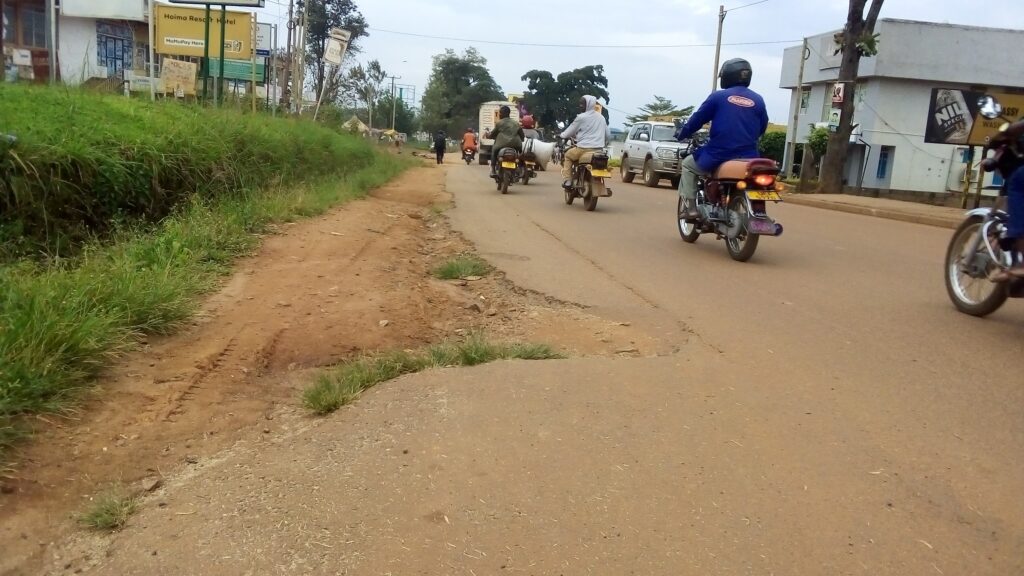Uganda at 60 has registered tremendous steady progress in infrastructural development which include among others; the 49.56 kilometre Kampala-Entebbe Expressway, the Jinja Bridge (actually an iconic project in East and Central Africa).
For us hailing from the oil-rich Bunyoro Sub region (currently common known as Mid-Albertine region) may not let the celebrations of infrastructural development diminish without mentioning the critical oil roads that have transformed the socio-economic development of the region.
This, however, has been attributed to the vigorous mixture of key oil and gas developments or projects such as TILENGA, Kingfisher, Kabaale industrial park and the East African Crude Oil Pipeline (EACOP).
For now, excuse me about the debates around the EACOP and we concentrate on Hoima-Kampala road.

While conducting my ethnographic studies in one of the Hoima-Kampala taxis, the whole journey was characterised by risks and uncertainties, that is to say competition for the right of way amongst the pedestrians, motorcyclists and truck drivers. That notwithstanding, in a period of two weeks, the region has experienced a big increase in the fleet of vehicles invading the key oil and gas producing areas. To be specific, specific trucks carrying parts of the Kingfisher rig left many mesmerised on the future of the road users of the narrow road thus many calling for redeployment of road blocks along the Kampala-Hoima highway. (Shame upon them for not considering presidential directive on the same)
On average, the critical oil roads such as the 111 kilometre, Hoima-Wanseko road took a minimum of 3 years.
This implies that as we envisage to fast track the first oil in 2025, we stand to witness the same period covered to renovate the road in question.
This may pose a devastating impact on the newly existing infrastructure (Renovation patches have already been witnessed on the section between Busujju and the Kampala northern by-bass at Namungona).
Important to note, Hoima city has become a blast furnace of enhancing patriotism for example presently, it is a unifying ground for all ethnic groups within and outside Ugandan boundaries.
I have on several occasions witnessed numerous stakeholders from Democratic Republic of Congo traversing via Hoima City to Kampala and back during wee hours.
These indirectly contribute to the economic growth of local governments and the country at large but ultimately exert pressure to the existing infrastructure and the plans in the pipeline.
The existing road network is the oldest tarmac road in Bunyoro Sub region, right from the times of demonstrations put forward by the then energetic youth and other stakeholders led by Mr. Ali Babi from the then Hoima town council as the secretary for production who threatened to walk up to Kampala around 2002/2003 while some of us were in primary 5 and 6, respectively.
Life seemed easy until recently when comparison analysis was done in relation to other modern infrastructure such as Kampala-Entebbe Express way in terms of width and durability.
That notwithstanding, Hoima-Kampala road remains a viable project in the following context;
It is the only highway lagging behind amongst the key highways connecting Kampala city to other key cities.
For example, Kampala city-Gulu city, Kampala City-Masaka/Mbarara Cities, Kampala City-Jinja city, Kampala City-Fort portal City but now overwhelmingly Kampala City-Hoima Oil city.
This has left Hoima city as a transit for only employment opportunities yet it is a destination for the virgin history in Uganda and the world at large. For example, it is an intersection of the now Albertine region districts.
As opposed to other infrastructural projects that have been delayed due to compensation issues, I presume that Hoima-Kampala road still possesses clear road reserves.
In events that some mushrooming town councils/trading centres along the way encroached on the road reserve, the respective duty bearers such as the physical planner should deal with such accordingly.
Upon being categorised as a critical oi road, it can easily attract the support from the Joint Venture Partners (JVPs)-CNOOC Uganda Limited, TotalEnergies Uganda and Uganda National Oil Company, who in their respective capacity have corporate affairs departments.
For example, it can be easy for the respective partners to fund the project in a view of recoverable costs given that the final investment decision for key project (EACOP) was signed and in the current atmosphere it is irreversible. It will not be the first aspect to be supported by the JVP.
For example in 2016, the JVP facilitated the development of the Land Acquisition Resettlement and Rehabilitation Framework (LARRF).
(The extent of its popularity amongst key stakeholders will also be a discussion for another day).
All mid-western region referrals are made through Hoima Regional Referral hospital (HRRH) and hence critically ill patients get subjected to anguishing humps along Hoima-Kampala road.
Retrospectively, we are likely to witness less productivity among labour force within Bunyoro Sub region or those coming to the region.
The overwhelming statistics during the commemoration of the World Mental Health Day on Monday (October 10, 2022) that is to say 35 out 100 Ugandans you meet may be battling a mental health problem, according to World Health Organization.
This implies that the daily admissions (850-1,000 patients) and more than 3,000 patients registered daily in the outpatient department at Butabika National Referral Mental Hospital may not be exceptional to exclude the patients from Bunyoro Sub region who traverses via the same road (Hoima-Kampala).
Production starts with the mind. Despite those working in the petroleum sector being cruised from Prado V8, New models of Toyota Double cabins, mere thinking about the risky road, characterized by “funny” humps, makes one sick and hence less production.
Regardless of other tourism destination centers in Bunyoro Sub region, tourists tend to bypass Bunyoro sub region or stop at its periphery like Murchison Fall National Park from Masindi side but not through Hoima City to possibly make a stopover at Kibiro salt mines and Hot springs, the ancient Bunyoro Kitara Kingdom, Mparo Tombs, Bugoma Forest despite its contentious issues to mention but a few.
All this limit efforts of maximizing domestic revenue from respective administrative units (Hoima City, Hoima District, Kikuube district etc.).
Therefore, as a seasoned patriotic young man, I envy the efforts to fast track regional (East Africa) integration through holistic infrastructural development given the fact that for holistic development to take place, there should be a deliberate sacrifice.
This is the time to sacrifice (close one eye) and fast track the renovation of the mighty Hoima-Kampala road.
The writer is a Social Scientist and Researcher-working as a coordinator-Bunyoro Albertine Petroleum Network on Environmental Conservation (BAPENECO) hosted by Kitara Civil Society Organizations’ Network (KCSON).
Email: dickensamanya@gmail.com Twitter: @dickensamanya

